Integrated high-pull wireline conveyance systems accelerate access to well profiles
Early this year, tension modeling of planned formation logging and sampling runs—in a highly tortuous deepwater Gulf of Mexico (GOM) well—indicated that extreme normal logging tensions up to 20,900 lbf would be likely. Conventional high-strength wireline cables allow only three pull cycles at a maximum of 21,000 lbf. If a toolstring became stuck, and additional pull cycles were required to free it, or if instantaneous pulls exceeded the cable’s safe working load, the operator would have faced a very costly fishing operation and the potential loss of vital reservoir information.
In the deepwater GOM, even a successful fishing job typically takes about four days of rig time. Fishing remains the single, highest contributor to flat rig time for wireline-related incidents. Globally, operators still spend more than 10,000 hr, each year, fishing wireline tools.
Accordingly, the deepwater operator would have decided to convey its logging and sampling toolstrings on drill pipe. However, in such a deep well with such a complex trajectory, pipe conveyance, itself, would have entailed a lengthy and expensive operation. Typically, pipe conveyance takes three to four times longer than wireline conveyance—a catch-22.
Fortunately, Schlumberger had just introduced the industry’s highest-pull wireline conveyance system. The MaxPull high-pull wireline conveyance system integrates an innovative polymer-encapsulated, torque-balanced composite cable, with an offshore winch unit, drum and capstan, capable of safely handling multiple pull cycles, up to 30,000 lbf. This is nearly 50% higher than the strongest conventional high-tension system.
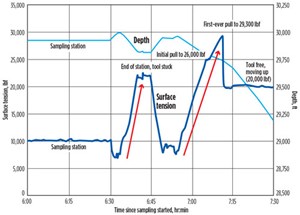
Using advanced conveyance planning software, engineers identified additional modular components to minimize operational risk, and maximize safety and efficiency. These included the WellSKATE low-friction well access accessories to ensure well access—despite variable hole conditions—and SureLOC, an electronically controlled release device. Both operate at the cable’s weak point, and at strategic positions along the toolstring.
Deploying the new high-pull wireline conveyance solution paid off. Upon completion of an extended sampling station, while running a formation dynamics tester, the cable became stuck. An initial pull at 26,000 lbf was not sufficient enough to free it. A pull in excess of 29,300 lbf was required to extract the stuck cable and the toolstring. Not only did this prevent the loss of critical fluid and pressure data needed to characterize the reservoir, but the operator avoided a four-day fishing job, which would have cost $3.05 million, Fig. 1.
The 30,000-lbf high-pull system is the second major upgrade to the industry’s only fully integrated wireline conveyance solution, first introduced in 2012. Today, more than 50 of these systems—with safe working loads of 18,000; 26,000; and 30,000 lbf—are deployed worldwide, mostly in deepwater environments.
Operators have saved more than $30 million by effectively replacing pipe conveyance, delivering longer, more comprehensive toolstrings in deeper wells, reducing the total number of wireline descents, forestalling costly fishing operations. Augmented with all-terrain openhole tractors and other downhole accessories, high-pull wireline conveyance systems can accelerate access to any wellbore profile today—regardless of deviation or complexity—at depths up to 40,000 ft.
EVOLUTION OF HIGH-PULL SYSTEMS
During the first decade of the 21st century, high-tension pulls on wireline logging toolstrings in deepwater GOM wells more than doubled, eventually exceeding 15,000 lbf. As logging tensions rose, broken cables, stuck tools, fishing incidents and associated costs increased sharply, as well. The rise in wireline tension was driven by the need for longer, heavier cables and larger, heavier toolstrings, with more sensors to acquire high-quality reservoir data in fewer runs.
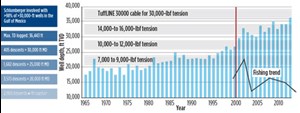
To boost wireline logging efficiency in increasingly deep wells, equipment suppliers introduced higher-strength cables, higher-capacity offshore winch units, reinforced drums, and capstan tension relief units. Typically, these and other components were manufactured by different vendors, purchased off the shelf and cobbled together. Often, it was difficult to determine a particular conveyance package’s actual pull capacity. Soon, premature cable failures began to climb again, due to torque-related breakage, core crushing or cold flow, and sometimes mismatched equipment.
To prevent cable-related incidents, engineers had to reduce the number of pull cycles and increase the number of cable replacements during logging jobs. However, both remedies—as well as the usual seasoning (stretching) required upon first unspooling a fresh cable—boosted total rig time spent on wireline operations.
In 2010, therefore, a cable with 21,000-lbf capacity was introduced in the deepwater GOM. Fishing incidents dropped to less than 1%. Apart from greater strength, however, the basic cable design remained unchanged. Thus, it was still susceptible to traditional weaknesses. Meanwhile, wells continued to penetrate deeper reservoirs; even higher logging tensions occurred; and fishing jobs still consumed three to four days of non-productive time, Fig. 2.
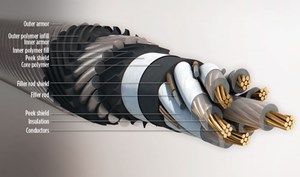
Following an in-depth evaluation of deepwater cable failures, the service company began research, engineering and testing of a breakthrough cable design, using polymer-locked armors that effectively overcame the limitations of conventional cables. The result was the TuffLINE torque-balanced composite cable, which required no seasoning and less maintenance. It quickly became the core of a new, integrated approach to high-pull wireline conveyance, Fig. 3. To ensure that the system was truly integrated, the company manufactured its own cables and all other components.
The original 18,000-lbf cable was first deployed in 2012, outside of the GOM, where high-tension logging pulls had begun to reach a minimum 10,000 lbf.
Eastern Mediterranean case study. The operator of a vertical deepwater exploration well, in a remote area of the Eastern Mediterranean, had planned wireline logging operations in the 12¼-in. and 8½-in. well sections. Simulations predicted normal wireline tensions of less than 8,000 lbf. No well deepening or sidetracks were expected. As such, the rig was not equipped with a capstan high-tension relief system.
However, the drillstring became stuck near the 12¼-in. section, TD, without having encountered the primary target reservoir. After a complex pipe recovery operation, drillers decided to sidetrack at 35° deviation. Modeling of expected wireline tensions along the new trajectory showed an increase of up to 8,000 lbf. To minimize risk, the 12¼-in. logging operation was split into three descents. Nevertheless, during the first run, even higher tensions were encountered. It became clear that normal logging tensions in the upcoming 8½-in. section would exceed 10,000 lbf. The current cable was not strong enough to handle loads of that magnitude.
Due to the well’s remote location, it was not possible to mobilize and rig-up a capstan in time to log the 8½-in. section on schedule. Only two conventional solutions were available: double the number of wireline runs, or convey the five planned descents on drill pipe, which would require seven days of rig time.
The service company suggested an alternative: deploy the new 18000 composite cable from the UK. It had been designed to handle up to 18,000 lbf, without a capstan, and the winch unit on the rig could already pull significantly more than the conventional cable. This is a good example of the component mismatches that often occur in the absence of an integrated approach to wireline conveyance.
In two days, while logging was completed in the 12¼-in. section, the new cable was mobilized. All five runs in the 8½-in. section were completed in just three days, despite the fact that toolstrings became stuck on every descent, due to poor hole conditions. Four of those runs encountered tensions exceeding 10,000 lbf. Multiple pulls, up to 16,000 lbf, were required to free stuck tools. Not only did the operator avoid a costly fishing operation, but it saved 96 hr (four full days) of rig time, worth $5 million, by eliminating pipe conveyance.
ADDITIONAL HIGH-PULL COMPONENTS
Obviously, efficient high-pull wireline conveyance requires more than a cable, no matter how advanced. What about highly deviated, horizontal, or complex well trajectories, especially with poor hole conditions? As soon as normal gravity descent becomes problematic, drillers typically resort to drill pipe conveyance. However, this tends to take three to four times longer than wireline, thereby increasing cost, operational complexity and risk.
Therefore, the service company developed a new UltraTRAC all-terrain wireline tractor—an openhole application technology equipped with low-friction rollers, hole finders and other well accessories as additional components of the evolving, high-pull wireline conveyance system. Together, they could negotiate washouts, and push or pull toolstrings weighing up to 8,000 lb. Tractor conveyance could accelerate wireline logging in a horizontal wellbore at a pace comparable with gravity descent in a vertical well of the same length. Today—combined with high-strength polymer-encapsulated, torque-balanced cables—openhole tractors can effectively replace pipe conveyance, enabling efficient wireline access to any well profile.
West Africa case study. A few years ago, for example, an S-shaped appraisal well offshore West Africa, with an openhole deviation of 75°, posed a significant logging challenge. The operator needed to run advanced sensors to fully evaluate the reservoir, rather than basic LWD tools. Initially, according to IADC/SPE paper 170565, wireline conveyance was ruled out, due not only to the high well deviation but also to the extremely unconsolidated formation, which had an unconfined compressive strength as low as 600 psi in places.
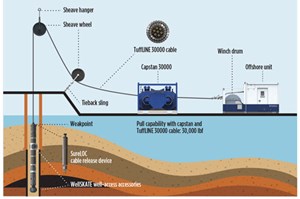
However, by adding new, all-terrain tractors to the integrated 18,000-lbf wireline conveyance system, the operator successfully acquired sophisticated petrophysical measurements, ran formation tests and obtained fluid samples in five logging runs, at a normal tension of 10,500 lbf—without getting stuck. Compared with pipe conveyance, the operator saved 72 hr, effectively cutting operational time in half.
FULLY INTEGRATED HIGH-PULL SYSTEMS
Over the past five years, high-pull wireline conveyance systems have come of age. Fully integrated components—no longer cobbled together off the shelf—include polymer-encapsulated cables; matching high-capacity, offshore logging units; winch drums; capstan tension relief systems; electronic cable release devices; well-access accessories; all-terrain, openhole tractors; advanced well conveyance planning and optimization software; and an optional field acquisition system that manages the extreme power, telemetry and data needs of today’s longer, more comprehensive wireline toolstrings, Fig. 4.
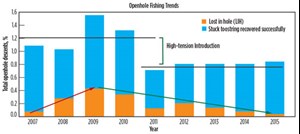
In October 2014, two years after introducing the MaxPull 18000 system, Schlumberger released an integrated 26,000-lbf high-pull system for the deepwater GOM. During the first year of the downturn, it saved operators more than 12 days of flat rig time, worth $9 million, by preventing four fishing jobs, which were otherwise unavoidable. In 2015, GOM wireline fishing incidents dropped to a record-low 0.4% of total descents. In March 2016, the new 30,000-lbf system—the highest-strength wireline conveyance system in the world—was commercialized, forestalling a $3-million fishing operation on its first deployment, as described at the beginning of this article, Fig. 5.
BENEFITS AND EFFICIENCIES
Although integrated high-pull wireline conveyance systems were originally developed for deepwater wells, today they can accelerate access to any offshore or land environment, regardless of the complexity, deviation or condition of the wellbore. Onshore operators all over the world are looking for increasingly efficient, higher-tension capabilities. By replacing drill pipe conveyance, these systems can safely deliver more wireline tool combinations to longer or deeper holes in a fraction of the time, with fewer descents, and at a lower cost.
An added benefit is that high-pull conveyance can eliminate potential conflicts between drillers and geoscientists over the number, weight and length of toolstrings that can be deployed to acquire essential data in challenging wells.
In the GOM, the two highest-strength MaxPull systems can now pull 25% to 50% more at the surface than the industry’s strongest conventional solution. Downhole, at the tool level, all-terrain tractors can push or pull an additional 2,500 lbf to 3,000 lbf. This means deepwater operators can actually pull in excess of 26,000 lbf to 30,000 lbf. In the near future, they may even deploy open-hole tractors in vertical holes and low-deviation wells, to ensure the lowest possible risk and cost. ![]()


